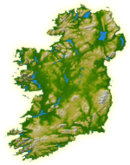
Gráinne O'Malley, also known as Grace O'Malley, was the head of the Ó Máille dynasty in the west of Ireland, and the daughter of Eóghan Dubhdara Ó Máille.

Connemara is a region on the Atlantic coast of western County Galway, in the west of Ireland. The area has a strong association with traditional Irish culture and contains much of the Connacht Irish-speaking Gaeltacht, which is a key part of the identity of the region and is the largest Gaeltacht in the country. Historically, Connemara was part of the territory of Iar Connacht. Geographically, it has many mountains, peninsulas, coves, islands and small lakes. Connemara National Park is in the northwest. It is mostly rural and its largest settlement is Clifden.

Clifden is a coastal town in County Galway, Ireland, in the region of Connemara, located on the Owenglin River where it flows into Clifden Bay. As the largest town in the region, it is often referred to as "the Capital of Connemara". Frequented by tourists, Clifden is linked to Galway city by the N59.

Oughterard is a small town on the banks of the Owenriff River close to the western shore of Lough Corrib in Connemara, County Galway, Ireland. It is located about 26 km (16 mi) northwest of Galway on the N59 road. Oughterard is the chief angling centre on Lough Corrib.
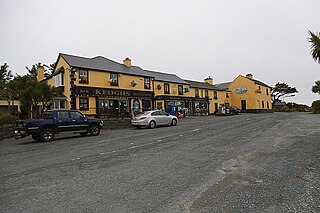
Ballyconneely is a village and small ribbon development in west Connemara, County Galway Ireland.

Inishbofin is a small island off the coast of Connemara, County Galway, Ireland. Inishbofin has around 180 inhabitants and is a tourist destination.

Letterfrack or Letterfrac is a small village in the Connemara area of County Galway, Ireland. It was founded by Quakers in the mid-19th century. The village is south-east of Renvyle peninsula and 15 kilometres north-east of Clifden on Barnaderg Bay and lies at the head of Ballinakill harbour. Letterfrack contains the visitors centre for Connemara National Park.
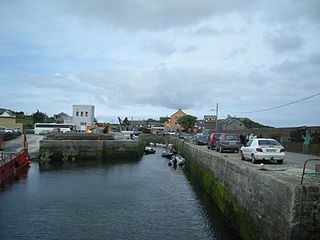
Cleggan is a fishing village in County Galway, Ireland. The village lies 10 km (7 mi) northwest of Clifden and is situated at the head of Cleggan Bay.

Claddaghduff is a village in County Galway, Ireland. It is located northwest of Clifden, the gateway to Omey Island.
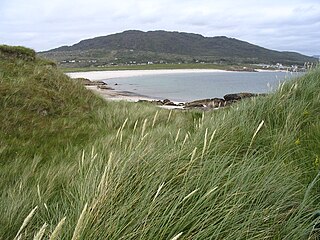
Errisbeg Mountain or Errisbeg is a hill in Roundstone, County Galway, in the West of Ireland, with a height of 300 m.
Mathias of Inis Ní was a Medieval Irish saint.

Toombeola is a townland in the historical barony of Ballynahinch in Connemara, County Galway, Ireland. It is located near the Atlantic Coast, 44 miles (71 km) west of Galway City, 4 miles (6.4 km) east of Roundstone, and 10 miles (16 km) south east of Clifden. As of the 2011 census, Toombeola townland had a population of 18 people.
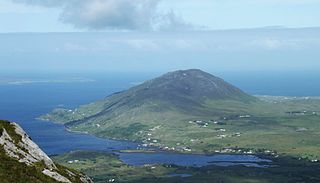
Letter Hill is a large hill near the coast to the north-west of Letterfrack in County Galway, Ireland. It is 356 m (1,168 ft) high and been listed as a Special Area of Conservation.

Tully Cross is a small village located on the Renvyle Peninsula in north-west Connemara, in County Galway, Ireland. It is actually situated in the townland of Gorteenclough. The village lies close to the sea and is on the Wild Atlantic Way coastal route.
Tully is a small village on the Renvyle Peninsula in north-west Connemara, County Galway, Ireland. It is situated on the Wild Atlantic Way coastal route.
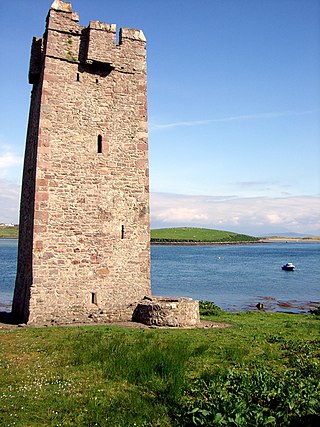
Carrickkildavnet Castle or Kildavnet Castle is a tower house and National Monument located in Achill Island, Ireland.

Ballynahinch Castle is a former Irish country house and estate, built on the site of a former castle, which is now a luxury hotel set in a private estate in the Connemara region of County Galway, Ireland. The castle lies on the edge of Ballynahinch Lake and Ballynahinch River, and is directly overlooked by Benlettery 557 metres (1,827 ft), one of the Twelve Bens mountain range.

The Galway to Clifden Railway or Connemara Railway was a railway line opened in Ireland by the Midland Great Western Railway (MGWR) in 1895. It led from Galway to Clifden, the chief town of the sparsely populated Connemara region in western County Galway. It was closed by the MGWR's successor, the Great Southern Railways (GSR) in 1935.

Caroline Blake born Caroline Johanna Burke was an Irish landlord and hotelier. She became responsible for land and its tenants in County Galway. The Land League encouraged her tenents to not pay their rents and this reduced her income. Her poor treatment led to well-wishers creating a "Blake Fund" which allowed her to create the hotel.



















